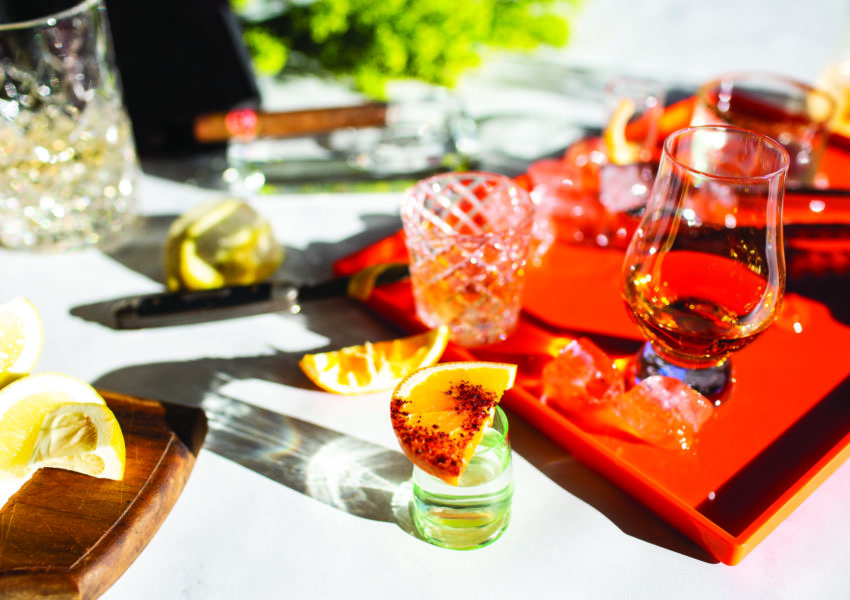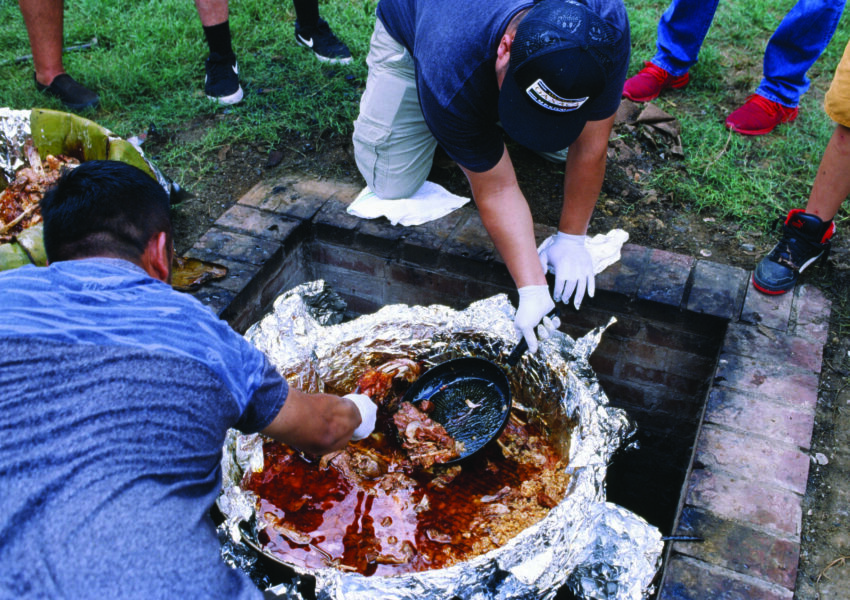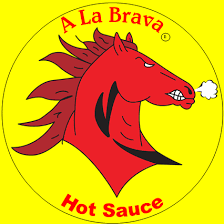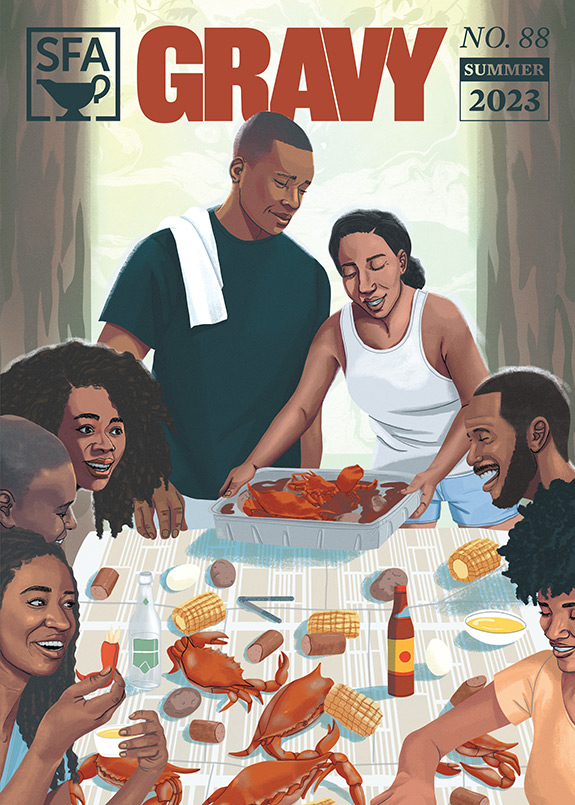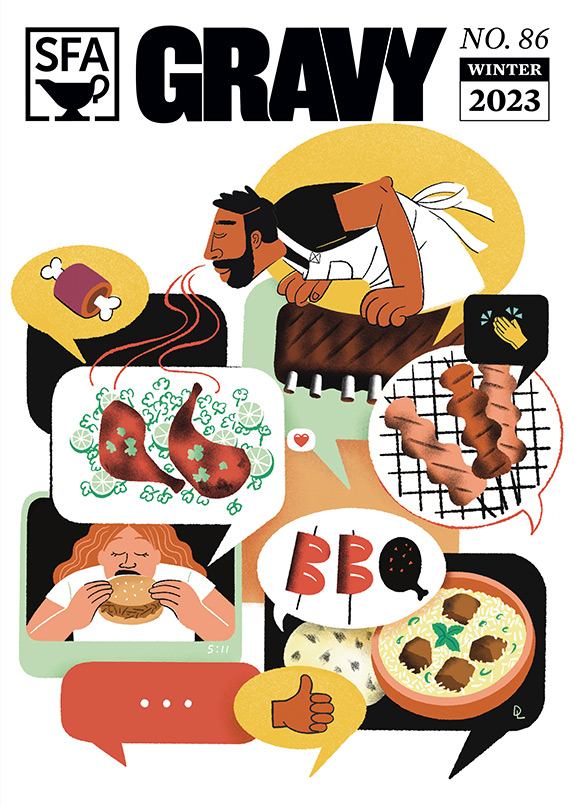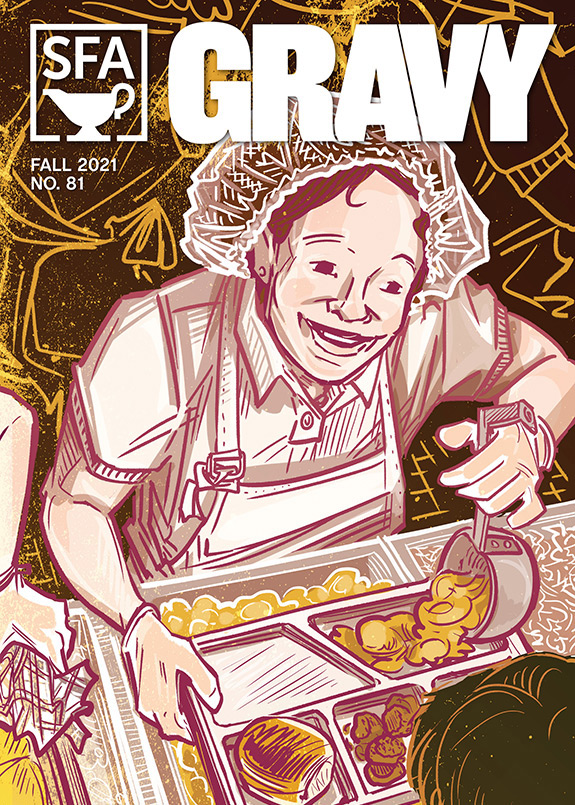This piece first appeared in issue #56 (summer 2015) of our Gravy quarterly. The author, Gustavo Arellano, is the editor of OC Weekly and the author of Taco USA: How Mexican Food Conquered America. He is also Gravy‘s first columnist. Check out his column, “Good Ol’ Chico,” in the fall issue of Gravy.
Keepers of Chipped Dreams
The Life, Death, and Eternal Allure of Ceramic Bourbon Decanters
by Gustavo Arellano
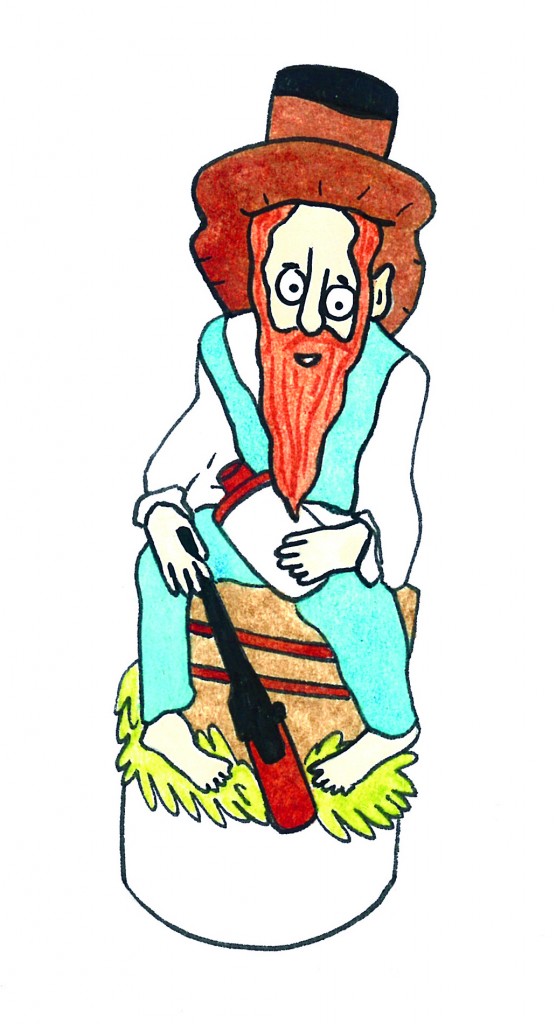
I call him Ezekiel, that 1969 Cabin Still ceramic bourbon decanter on my work desk molded in the shape of a stereotypical hillbilly. Bearded, barefoot, and slouching on a barrel, wearing a floppy hat and overalls and holding a shotgun and a whiskey jug, he looks like an Ezekiel—which is to say, he’s a dead ringer for my favorite uncle, mi tío Ezequiel. A fun-loving guy always up for a nip of white dog (or its Mexican cousin, mezcal), with a great name that somehow never joined Elijah and Ezra in the canon of good, cheap Biblical bourbon.
Ezekiel the Decanter has guarded my office for two years now. I bought him somewhere in Kentucky as part of my pickings from the 127 Yard Sale, that mega-flea market happening the first weekend of every August from Gadsden, Alabama, through Covington, Kentucky. I’ll always keep Ezekiel close to me, not because it cost just $25 to score him and a two-foot-tall replica statue (his name is Enoch—gotta keep up with the Good Book!), but because that’s the summer I decided to collect as many bourbon decanters as possible.
They had intrigued me ever since I saw a 1997 Simpsons episode where Marge told a novelty store owner—played by cult director John Waters—that a Confederate soldier statue owned by her grandmother was worth a fortune. The store owner pointed out that it was just a whiskey holder that cost “two books of green stamps, if I’m not mistaken.”
My eighteen-year-old self laughed doubly—at the joke, yes, and at the idea that anyone would ever want to collect such cheesy things. Commemorative china plates, I understood. Porcelain dolls, sure. But bourbon decanters molded in the shape of humans? How déclassé. How antiquated. How Southern.
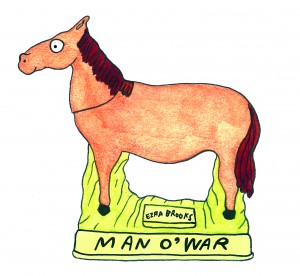 Today, I own over forty of them, in the form of: The state of Ohio. A train. Legendary thoroughbred Man o’ War. Old cannons. King Kamehameha. The Governor’s Palace in Williamsburg, Virginia. Special editions honoring the 200th anniversary of California’s Catholic mission system, or the Rocky Mountains. Do I have a bottle citing the third running of the Kentucky Pacing Derby at the old Louisville Downs? You know it!
Today, I own over forty of them, in the form of: The state of Ohio. A train. Legendary thoroughbred Man o’ War. Old cannons. King Kamehameha. The Governor’s Palace in Williamsburg, Virginia. Special editions honoring the 200th anniversary of California’s Catholic mission system, or the Rocky Mountains. Do I have a bottle citing the third running of the Kentucky Pacing Derby at the old Louisville Downs? You know it!
What changed? Well, I’m thirty-six now, so collecting ceramic bourbon decanters (also known as figurals) is a cheaper—and more age-appropriate—hobby than getting into model trains. And it helps that I’m a functioning borracho fascinated by bourbon culture. I used to only think of these unique bottles as a punchline. Now, I see them for what they are: keepers of chipped dreams.
They were a national obsession for decades for the Silent Majority, a buttress against Flower Power’s chaos and the materialism of the Me Decade: bought, sold, and traded with the same vigor that people once swapped baseball cards or Beanie Babies. Clubs formed around the passion; newspapers heralded conventions where hobbyists brought their wares for an impressed public to view. Collecting bourbon decanters was a way for working-class folks to feel like they were investing in something tangible that could double as decoration: a marker of a well-kept home.
Today, you can find figurals sold en masse in yard sales or on eBay, most fetching about fifteen bucks.
When I buy them during the 127 Yard Sale, the vendors always package them carefully, whether they’re in mint condition or have faded colors or labels. It’s bittersweet for them. They just made a sale, but many start telling me stories about the decanter while searching for newspaper and bubblewrap: how long it was in their family, the fun the bourbon inside inspired. The 1970s and 1980s were the days for decanters; now, they’re disposable, glazed curios of yesteryear.
***
Mankind has decorated its liquor vessels since antiquity—it’s as if there’s something hardwired into our livers that demands festivity at all stages when we drink. Greek and Roman amphorae depicted merry gods; Mayan lords marked their drinking cups with glyphs and scenes from mythology. In the United States, whiskey bottles from the 1800s into World War II often featured etchings or reliefs of Americana or heroes of the time: the Stars and Stripes, bald eagles, George Washington.
Bourbon distillers skipped pomp and circumstance in the early days—a label or the name of the company would do. That changed in the 1940s, when Jim Beam began issuing fancy bottles under its Pin Bottle series, so named because they were molded in the shape of bowling pins. In 1955, for the 160th anniversary of the brand, Beam unveiled a Royal Porcelain Anniversary Bottle, containing hooch aged 160 months. “Beam Bottles were never meant to be concealed,” boasted a 1955 LIFE Christmastime ad for the collectible. It featured a man in suit and tie sitting at a table with his hands behind his back, happily gazing at the Royal Porcelain and Pin Bottle before him as other presents remained wrapped, already forgotten.
The special edition was the idea of Martin Lewin, a German immigrant who worked with the company as a consultant; corporate lore maintains Lewin thought of the idea as an easy way to sell off overstock bourbon. The Royal Porcelain sold so well that the following year, Lewin unveiled the company’s first truly figural decanter: an elephant-and-donkey set in honor of the 1956 presidential election, designed so that each could hold a drink and serve as an ashtray when laid on its side. I have them both.
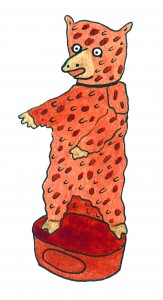 An industry was born. Not only did Jim Beam start releasing multiple bottles a year, its competitors followed suit. By 1966, the first official Jim Beam decanter club formed in—of all places—Berkeley, California. Lewin—by then Beam’s director, and eventually its president—helped found the International Association of Jim Beam Bottle & Specialties Clubs (IAJBBSC) as a way to foster a growing subset of Beam’s consumers. But the bourbon decanter fad didn’t become an American phenomenon until the entrance of Ezra Brooks and its visionary vice-president, Mike Wayne.
An industry was born. Not only did Jim Beam start releasing multiple bottles a year, its competitors followed suit. By 1966, the first official Jim Beam decanter club formed in—of all places—Berkeley, California. Lewin—by then Beam’s director, and eventually its president—helped found the International Association of Jim Beam Bottle & Specialties Clubs (IAJBBSC) as a way to foster a growing subset of Beam’s consumers. But the bourbon decanter fad didn’t become an American phenomenon until the entrance of Ezra Brooks and its visionary vice-president, Mike Wayne.
Wayne was a bourbon veteran. He joined the industry in 1933 and helped Ezra Brooks enter the figural game in 1967 with a replica flintlock (I own this one, too). In 1969, Wayne issued a decanter in the shape of the eighteen-karat Golden Rooster on display at the Nugget Casino in Sparks, Nevada. Originally priced at $15, it quickly went for over $200 within months. Two years later, Wayne attracted national attention after releasing a limited-edition decanter in the shape of a kachina, the ceremonial dolls used by Hopi Indians.
The tribe protested, enlisting Arizona Senator Barry Goldwater to have Ezra Brooks stop production.
A p.r. disaster seemed imminent—“How would a Catholic feel,” the Hopi tribal chairman asked Time, “about putting whisky in a statue of Mary?”—and he threatened a lawsuit. Instead, Wayne announced that production of the kachina decanter would end immediately, so that only 2,000 of the original 4,000 run ever appeared. He then arranged for Goldwater to smash the decanter’s original mold, public penance for Jim Beam’s wicked, firewater-loving ways. It was a brilliant publicity coup—a bottle originally priced at $25 immediately became a rarity and was selling for over $1,000 within weeks. Wayne never bothered to tell the public that company policy dictated all decanter molds be destroyed after their initial run—an easy way to drive up value for collectors.
The two companies invested in factories to mass-produce decanters, creating a china race. Ezra Brooks and Jim Beam supported bottle clubs and Ezra also sponsored a newsletter, Ezra’s Heritage Gazette. And while each helped independent authors compile annual guides showcasing decanters, it was Ezra that put out its own publication, Western Collector’s Handbook and Price Guide to Ezra Brooks Ceramic Decanters. The booklet not only showed all of Ezra’s figurals, but included a directory of clubs, a behind-the-scene guide that disclosed how the company decided which designs to produce (by a committee of execs who solicited ideas from across the country), and photos inside the Heritage China factory. It even reprinted a letter by president Thomas R. O’Shea, outlining his company’s decanter philosophy:
Because of the bottle collector’s support of EZRA BROOKS we are conscious of a moral responsibility which impels us to help improve the hobby of ‘Bottle Collecting’ and to express our profound gratitude toward those people who have chosen to collect our bottles. Therefore…we will never knowingly do anything in the marketing of our ceramic bottles which is not in the best interest of the collector.
 Regardless of producer, decanter subjects were gloriously square even by 1970s standards. Popular themes included wildlife, famous buildings, homages to states and pioneer days—sometimes lifelike, sometimes not. Wild Turkey featured its namesake bird. Beam and Brooks offered limited-edition bottles to commemorate conventions, liquor stores, college football bowl games, and fraternal organizations. A 1975 Jim Beam release depicted nothing more than a pair of military boots covered by an Army helmet. Titled “Short Timer,” the 1985 A Guide to Jim Beam Bottles said that it was the company’s best seller ever.
Regardless of producer, decanter subjects were gloriously square even by 1970s standards. Popular themes included wildlife, famous buildings, homages to states and pioneer days—sometimes lifelike, sometimes not. Wild Turkey featured its namesake bird. Beam and Brooks offered limited-edition bottles to commemorate conventions, liquor stores, college football bowl games, and fraternal organizations. A 1975 Jim Beam release depicted nothing more than a pair of military boots covered by an Army helmet. Titled “Short Timer,” the 1985 A Guide to Jim Beam Bottles said that it was the company’s best seller ever.
Non-distillers got into the mix, including two enterprises that sold pricier and even more realistic decanters: Lionstone Bourbon and Ski Country. Figurals were a lucrative business—in 1980, the Associated Press caught up with Mike Wayne, by now a Beverly Hills resident who had just dropped a cool $1 million for the rights to a painting of John Wayne (no relation) that he put on ceramic flasks for his own Mike Wayne Distillery line. “It’s a piece of art,” said Wayne, speaking of the bourbon decanters he helped to popularize. “Something that should last a thousand years if handled properly.”
And as if in answer the Hopi chairman’s question: Wayne went on to produce a twenty-three-karat gold-plated amaretto decanter in the image of Blessed Pope John Paul II.
***
The decanter’s glory days arguably ended in the summer of 1987, when the McCormick Distilling Company announced they were releasing their thirty-seventh and final Elvis Presley figural. “We feel we’ve done our thing with Elvis. He’s been good to us,” a vice-president told the AP. After more than 120,000 sold, ranging in price from $65 to $400, the firm was moving on—and so was nearly everyone else.
“There are many reasons it stopped, not just one reason,” says Michael Veach, author of Kentucky Bourbon Whiskey: An American Heritage. “Decanters are a pain to bottle, so the distilleries were happy to get out of the business. I suspect that when sales improved to a point they no longer needed them to support production, they quit doing it.”
Bourbon brands consolidated during the 1980s. As bigger companies swallowed up smaller labels, they left the decanter game for good, along with the institutional support for collectors. The Ezra Brooks clubs are no more; in 2012, Jim Beam released a limited-edition decanter of its American Stillhouse—its first release in more than a decade. The biggest collector’s group remaining is IAJBBSC, whose website (with a design out of the Geocities days) boasts seventy-five chapters with about 1,500 members—a far cry from an estimated 10,000 members cited by a Chicago Tribune article in 1988. Their forty-fifth annual convention is scheduled for this July at the Sheraton Hotel in Milwaukee—if I can’t make this time, I’ll definitely try for the next one.
I find it telling that in the present day, the one spirit that carries on the tradition of chintzy bottling is tequila. From bottles shaped like skulls to guns, agave plants, big-breasted women, classy pottery, Aztec emperors, and more, many a middle-class Mexican-American proudly shows off their collection at home, long after the tequila is gone. Like a previous generation of Americans with their bourbon figurals, a tequila decanter for us is not just a decanter: It’s a signifier of culture, a marker of aspirations, a keeper of ambition. And, oh yeah, the booze.


